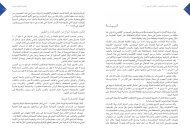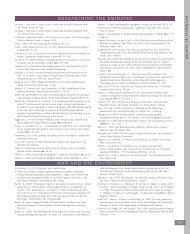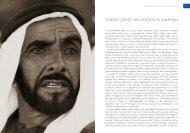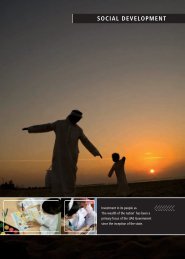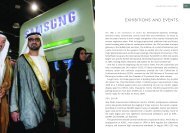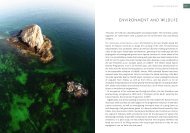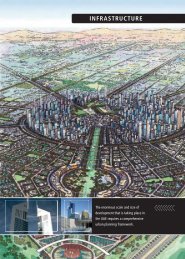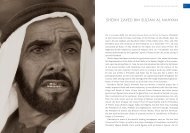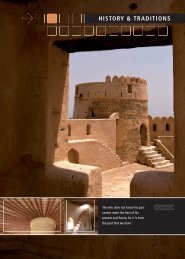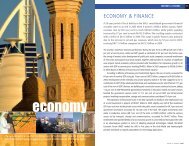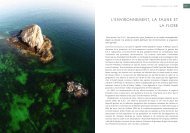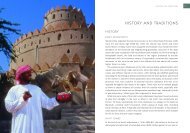168UNITED ARAB EMIRATES YEARBOOK 2006<strong>ECONOMIC</strong> <strong>DEVELOPMENT</strong>169FISHERIESMarine and fisheries resources have always occupied an important place in the<strong>UAE</strong> and still do so today. Apart from supporting a traditional way of life that canbe traced back to the earliest known archaeological sites in the region some 7500years ago, these resources still provide an important source of income, food andrecreational opportunity for many residents. Typical of the global trend, and inresponse to a growing demand for fishery and marine products, the last threedecades have seen increased use of marine resources in the <strong>UAE</strong>. During thisperiod, the traditional commercial fishing sector has substantially invested inmodern fishing fleets, while a growing tourism industry has led to an increase inthe use of fisheries and marine resources for recreation.All this has inevitably led to concern regarding the sustainability of the use ofthe fisheries resources. In particular, questions pertaining to depletion of thefish stocks, habitat degradation, and over-fishing have been raised and fisherymanagement strategies are being put in place (see section on Environment andWildlife). A recently-completed report undertaken by EAD (previously ERWDA),in Abu Dhabi, in association with the <strong>UAE</strong> Ministry of Agriculture and Fisheriesand Australian/New Zealand consultants has highlighted some of these issues,including a catastrophic decline in some stocks of commercial fish species.Some of the key outputs of the marine resources survey, on which the reportwas based include information on species identification, a catalogue of all speciescaptured, and statistics such as length/frequency data and catch rates for thekey species. This work was carried out from a research vessel that traversed thecoastal waters of the <strong>UAE</strong> undertaking habitat mapping and sampling.A variety of fish are caught in the <strong>UAE</strong>, including sharks and rays, catfish,lizardfish, flatheads, groupers, jacks, mojarras/silver-biddies, angelfish, grunts,parrotfish, wrasses, rabbitfish, barracudas, ponyfish, snappers, threadfin bream,emperors, seabream, goatfish, turbots, flounders and tonguesoles. A combinationof over-exploitation and degradation of the environment has been a major causeof the overall decline in fish stocks in the area. Environmental degradationincludes temporary or permanent elimination of important nursery areas byland reclamation in coastal areas, and increased marine pollution by dischargeof liquid and solid wastes into the marine environment.The dhow-based fishery, responsible for the majority of commercial fishing in<strong>UAE</strong> waters, comprises mostly small commercial operations. Wooden dhowsare usually about 12 to 20 metres in length, powered by 150 to 300 horsepowerinboard diesel engines. Dhows typically fish with baited basket traps (gargour,plural garagir), trawls, hook and line and trolling lines. Drift nets used to be adominant fishing method, especially for large pelagic species. These nets, knownas al-hayali, are now banned by law, except in tightly-regulated circumstances.Trap fishing using garagir is the most common fishing method, with over 80 percent of landed fish caught in these traps. Formerly made from interwoven palmfronds, the traps are now manufactured from galvanised steel wire of 1 to 1.5millimetres thickness, imported from the Far East. Garagir are usually made asdome-shaped traps with a base diameter of between 1 to 3 metres supported byreinforced steel bars and a funnel-like entrance. These traps are usually set inthe afternoon and the fish are retrieved after three or four days in the earlymorning. A variety of baits are used inside the traps, including green algae, grounddry fish, dead fish and bread. They mostly comprise groupers (hamour), emperors(shaeri) and grunts together with snappers, sea bream, parrotfish and rabbitfish.Gillnets (al-liekh) are often set on the seabed. They catch a variety of fish,including grunts, sea bream, emperors, goatfish, rabbitfish, pomfrets and others.Fishing by hook and line (hadaq) is specifically used for the capture of groupers,cobias, jacks/trevallies, grunts, emperors, sea bream and Spanish mackerel. Longlines(manshalla), which may have 10 to 20 extra smaller lines and hooks, aresometimes used. These are good for catching requiem sharks and groupers.Apart from gillnets, two other types of fishing nets are used. Beach seines (yaroof)can be up to 40 metres or more in length. One end of the seine is moved rapidlyfrom the shore in a wide arc in an effort to surround fish, both ends of the seinethen being pulled to shore. Fishing by this method remains fairly common onthe <strong>UAE</strong>’s East Coast, and can be seen, for example, at Fujairah and Dibba, thefishermen often being accompanied by large flocks of feeding gulls and terns.Speedboats with outboard motors and four-wheel drive vehicles are used todayto pull these seine nets to the shore, but traditionally this was done by a largegroup of men. This method was especially good at catching mojarras/silver-biddies,flathead mullets and rabbitfish. Many other fish are also caught, including smallneedlefish and jacks/trevallies.The bell-shaped cast net (salieya), which has small weights around its base tomake it sink, is also used at times of year when fish such as the Indian oilsardine and flathead mullets are abundant in shallow inshore waters.Fixed shore traps or hadrah were traditionally built by driving a row of palmfronds and wooden stakes but are now made with steel or iron poles and wiremesh or nylon netting. In the <strong>UAE</strong>, these traps are used during the summermonths, to catch the blackspot snapper, needlefish, jacks/trevallies, sea bream,mullets, barracuda and rabbitfish and, occasionally, other bottom species.Recreational fishing in the region is growing rapidly and is largely carried outfrom small motorboats operating relatively close to shore. A licensing system forall recreational fishing, whether from boats or from the shore, was introduced inthe Emirate of Abu Dhabi in 2002, as a by-law under Federal Law No. 23 for 1999on Exploitation, Protection and Development of Marine Bio-Resources. The licencesfor recreational fishing allow only two methods, handline and rod and reel. All
170UNITED ARAB EMIRATES YEARBOOK 2006fishermen over the age of 18 must obtain a licence, valid either for a year or fora week, although children can continue to fish in the company of a licence holder.Recently, a new licence category, the traditional fishing licence to cater for nationalfishermen who do not fall under either commercial or recreational fishing categories,was introduced. Competent authorities in each emirate are responsible for licensing.In Abu Dhabi, licences for both commercial and recreational fishing are issued byEAD, with an upper limit of 1000 being set on commercial licences.In April 2000, a regulation stipulating that no fishing boat is allowed to sailwithout the owner or a national or GCC captain on board, as provided for in FederalLaw No. 23 of 1999, was introduced. Fishing boats are now only permitted tosail if their national or GCC owner or captain is aboard. The Frontier and CoastGuard patrols stop any boat that violates this rule. Article 26 of the law banned theuse of fixed or drifting hayali fishing nets in Abu Dhabi waters. Each fishing boatformerly carried 20 to 50 drift nets, which often caught and drowned endangeredspecies such as dugong, dolphins and turtles. The nets also damaged commercialfish stocks, catching fish that were not brought to market or fish of no commercialuse. Problems still remain, however, such as the removal of fins from sharks forlucrative trade with the Far East. This has decimated the shark population of theArabian Gulf in recent years.AQUACULTUREThe focal point of aquaculture in the <strong>UAE</strong> is the Marine Resources Research Centre(MRRC) of the Ministry of Agriculture and Fisheries, based in Umm al-Qaiwain.Founded in 1978 under the terms of a technical cooperation programme betweenthe <strong>UAE</strong> and Japan, it began operations in 1984, and has succeeded in developinga suitable technology for growing rabbitfish from induced spawned eggs tomarketable-size fish. Work has also been carried out on shrimp-farming, both atUmm al-Qaiwain and on Abu al-Abyadh Island in Abu Dhabi.In 1999, the International Fish Farming Company (ASMAK) was set up underthe <strong>UAE</strong> Offsets Programme, with a total capital of Dh300 million. The companyspecialises in fish- and shrimp-farming and has 31,000 investors and shareholdersfrom different emirates. Its projects include the Middle East’s largest commercialhatchery for finfish, in Umm al-Qaiwain, and other facilities at Dibba in Fujairahand in Ra’s al-Khaimah, the latter two having a combined capacity of 3200 tonnesof fish. One of the objectives of the company, which also operates in Oman andKuwait, is to replace wild-caught fish, thus reducing the pressure on fish stocks.Fish-farming is likely to be developed further in the future and both ASMAK andthe MRRC at Umm al-Qaiwain are active in promoting the industry.



